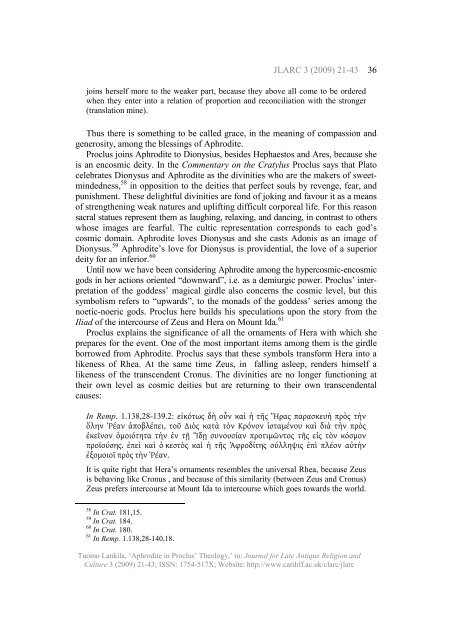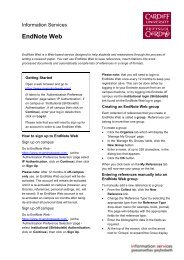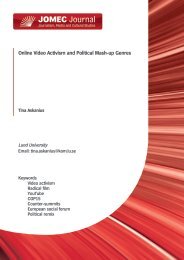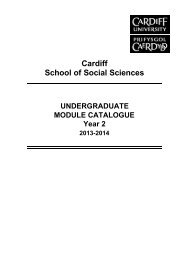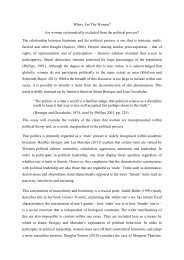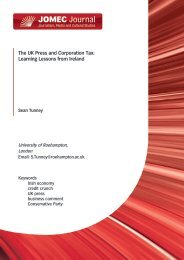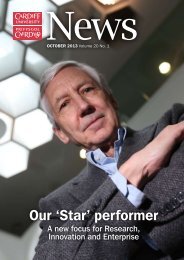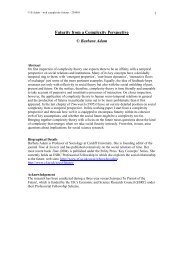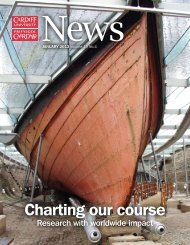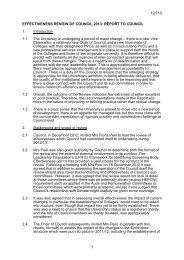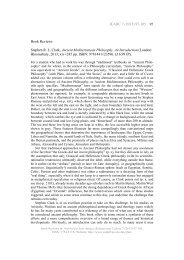APHRODITE IN PROCLUS' THEOLOGY - Cardiff University
APHRODITE IN PROCLUS' THEOLOGY - Cardiff University
APHRODITE IN PROCLUS' THEOLOGY - Cardiff University
Create successful ePaper yourself
Turn your PDF publications into a flip-book with our unique Google optimized e-Paper software.
JLARC 3 (2009) 21-43 36<br />
joins herself more to the weaker part, because they above all come to be ordered<br />
when they enter into a relation of proportion and reconciliation with the stronger<br />
(translation mine).<br />
Thus there is something to be called grace, in the meaning of compassion and<br />
generosity, among the blessings of Aphrodite.<br />
Proclus joins Aphrodite to Dionysius, besides Hephaestos and Ares, because she<br />
is an encosmic deity. In the Commentary on the Cratylus Proclus says that Plato<br />
celebrates Dionysus and Aphrodite as the divinities who are the makers of sweetmindedness,<br />
58 in opposition to the deities that perfect souls by revenge, fear, and<br />
punishment. These delightful divinities are fond of joking and favour it as a means<br />
of strengthening weak natures and uplifting difficult corporeal life. For this reason<br />
sacral statues represent them as laughing, relaxing, and dancing, in contrast to others<br />
whose images are fearful. The cultic representation corresponds to each god’s<br />
cosmic domain. Aphrodite loves Dionysus and she casts Adonis as an image of<br />
Dionysus. 59 Aphrodite’s love for Dionysus is providential, the love of a superior<br />
deity for an inferior. 60<br />
Until now we have been considering Aphrodite among the hypercosmic-encosmic<br />
gods in her actions oriented “downward”, i.e. as a demiurgic power. Proclus’ interpretation<br />
of the goddess’ magical girdle also concerns the cosmic level, but this<br />
symbolism refers to “upwards”, to the monads of the goddess’ series among the<br />
noetic-noeric gods. Proclus here builds his speculations upon the story from the<br />
Iliad of the intercourse of Zeus and Hera on Mount Ida. 61<br />
Proclus explains the significance of all the ornaments of Hera with which she<br />
prepares for the event. One of the most important items among them is the girdle<br />
borrowed from Aphrodite. Proclus says that these symbols transform Hera into a<br />
likeness of Rhea. At the same time Zeus, in falling asleep, renders himself a<br />
likeness of the transcendent Cronus. The divinities are no longer functioning at<br />
their own level as cosmic deities but are returning to their own transcendental<br />
causes:<br />
In Remp. 1.138,28-139.2: εἰκότως δὴ οὖν καὶ ἡ τῆς Ἥρας παρασκευὴ πρὸς τὴν<br />
ὅλην Ῥέαν ἀποβλέπει, τοῦ ∆ιὸς κατὰ τὸν Κρόνον ἱσταμένου καὶ διὰ τὴν πρὸς<br />
ἐκεῖνον ὁμοιότητα τὴν ἐν τῇ Ἴδῃ συνουσίαν προτιμῶντος τῆς εἰς τὸν κόσμον<br />
προϊούσης. ἐπεὶ καὶ ὁ κεστὸς καὶ ἡ τῆς Ἀφροδίτης σύλληψις ἐπὶ πλέον αὐτὴν<br />
ἐξομοιοῖ πρὸς τὴν Ῥέαν.<br />
It is quite right that Hera’s ornaments resembles the universal Rhea, because Zeus<br />
is behaving like Cronus , and because of this similarity (between Zeus and Cronus)<br />
Zeus prefers intercourse at Mount Ida to intercourse which goes towards the world.<br />
58 In Crat. 181,15.<br />
59 In Crat. 184.<br />
60 In Crat. 180.<br />
61 In Remp. 1.138,28-140,18.<br />
Tuomo Lankila, ‘Aphrodite in Proclus’ Theology,’ in: Journal for Late Antique Religion and<br />
Culture 3 (2009) 21-43; ISSN: 1754-517X; Website: http://www.cardiff.ac.uk/clarc/jlarc


